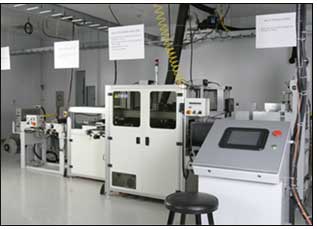If RFID is going to truly transform the global supply chain, then there needs to be an inexpensive way to mass-assemble RFID tags. Matrics, the Rockville, M.D.-based RFID systems provider, recently gave RFID Journal an exclusive look at its new PICA—Parallel Integrated Chip Assembly—machine, which the company says can produce hundreds of millions of RFID inlays per year.
RFID tags have been assembled using flip-chip machines, which pick up one microchip at a time, flip it over and press metal pads on the chip to a metal or conductive-ink antenna. The chip and antenna are bonded using an isotropic glue that conducts electricity. Most flip-chip machines can assemble no more than 8,000 tags per hour.
The PICA machine—located in an industrial facility a stone’s throw from Baltimore/Washington International Airport, in Maryland—uses a process that allows several chips to be simultaneously placed on antennas and cured quickly. Matrics says the PICA machine can assemble 14,400 to 100,000 units (tags or straps) per hour, depending on the size of the antenna (with smaller antennas, more tags can be assembled at one time).
Here’s how PICA works. Matrics purchases microchips from a semiconductor company. The microchips arrive on an 8-inch silicon wafer that the chipmaker had placed on a piece of plastic tape and then cut into chips. At Matrics’ facility, the wafer, which is held together by the tape, is optically aligned with a punch plate—a plastic plate with tiny holes that match the size of each microchip (different plates are used for different-size chips). The wafer and punch plate are then locked together in a jig and placed in the PICA machine under the head of the assembly machine, which is essentially a block with pressure-sensitive pins.
Matrics also purchases antennas printed with conductive ink from a company called Graphic Solutions of Burr Ridge, Ill. The antennas come on a roll of clear plastic tape with holes along the left and right side, similar to a roll of film. The plastic tape is fed onto rollers with pins. As the rollers turn, the pins pull the plastic tape through the PICA machine. The rollers are controlled by computers that move them from side to side to align the antennas on the plastic tape with the PICA machine’s head.
As the tape moves through the 20-foot-long machine, it passes several stages. First, dust is brushed off the antennas to ensure a good bond between the chip and antenna. Then, an anisotropic adhesive is applied to spots on each antenna where the chip will be attached. Tiny pins dipped in the adhesive dab the glue onto several antennas simultaneously (there may be two, three or more antennas across the width of one plastic tape, depending on the size of the tag).
As the antennas move forward, they come under the head of the PICA machine. The pins on the head push down and press several microchips simultaneously onto the antennas. Twelve 2- by 4-inch tags can be assembled simultaneously. If the machine is making tags with smaller antennas, more antennas can fit under the head (which is only as a large as the 8-inch wafer) and therefore more tags can be assembled simultaneously.
After the microchip is punched down onto the antenna, a flash of ultraviolet light instantly cures the adhesive. This is a critical element in boosting the speed of production. Many adhesives used today take several seconds to cure using heat, which slows down the production process.
As the antennas’ plastic tape moves forward through the machine, each newly assembled tag is tested to make sure it works and the tape is sliced to create separate inlays, which are put into magazines that are supplied to label converters. The label converter will then sandwich each inlay between a paper label and an adhesive layer to create a finished RFID tag.
Matrics cofounder and CTO Michael Arneson came up with PICA concept. He says the machine costs about $1 million to build, which is cheaper than some existing tag assembly machines. “PICA brings a throughput in units per hour that is substantially larger than what flip-chip or any other assembly technology can do today,” he says. “And we can do it at a capital efficiency that is much better than what anyone else can do.”
Matrics began production of tags using the PICA process in September, running the machine only half of an 8-hour shift per day. The company says it can produce 15 million 4- by 4-inch label inlays, 100 million 1- by 1-inch label inlays or 800 million straps (chips placed in a substrate with metal connectors that can later be attached to an antenna) per year with half a shift, and that is enough to meet the demand for now.


